Contents
- History
- Ancient Trade Routes
- Ghodas & Ghodbunder
- Fryer’s Journey Through Thana (1675)
- Colonial-Era Road Development
- Modes of Transportation in the District
- Railway Systems
- Ferries & Water Transport
- Overview of Bus Networks
- Autos & Shared Vehicles
- Traffic Map
- Communication Networks
- Newspapers & Magazines
- Graphs
- Road Safety and Violations
- A. Cases of Road Safety Violations
- B. Fines Collected from Road Safety Violations
- C. Vehicles involved in Road Accidents
- D. Age Groups of People Involved in Road Accidents
- E. Reported Road Accidents
- F. Type of Road Accidents
- G. Reported Injuries and Fatalities due to Road Accidents
- H. Injuries and Deaths by Type of Road
- I. Reported Road Accidents by Month
- J. Injuries and Deaths from Road Accidents (Time of Day)
- Transport Infrastructure
- A. Household Access to Transportation Assets
- B. Length of Roads
- C. Material of Roads
- D. Licenses Issued
- Bus Transport
- A. Number of Buses
- B. Number of Bus Routes
- C. Length of Bus Routes
- D. Average Length of Bus Routes
- E. Daily Average Number of Passengers on Buses
- F. Revenue from Transportation
- G. Average Earnings per Passenger
- Communication and Media
- A. Household Access to Communication Assets
- B. Newspaper and Magazines Published
- C. Composition of Publication Frequencies
- Sources
THANE
Transport & Communication
Last updated on 6 November 2025. Help us improve the information on this page by clicking on suggest edits or writing to us.
Thane, historically, has been a significant trading hub and holds a notable place in the early development of India’s railway system. Over the years, many infrastructure developments have been undertaken to accommodate both local and external transportation needs.
History
Ancient Trade Routes
Transportation networks have always been essential to human civilization, as they connect distant regions and support the exchange of goods, ideas, and cultures. They have shaped economies, and they have helped communities grow through trade and communication. Throughout history, ancient trade routes and transport networks stretched across vast distances, linking distant regions and facilitating the exchange of goods, ideas, and cultures. In India, traces of this exchange remain, hinting at connections that reached as far as Rome and the Arab world. Thane, with its strategic location by the coast, played a pivotal role in this age-old network.
It has a rich history of maritime commerce dating back to prehistoric times, with far-reaching connections with many civilizations and Kingdoms. According to the district colonial Gazetteer (1882),
“From pre-historic times the Thana coast has had relations with lands beyond the Indian Ocean. From B.C. 2500 to B.C. 500 there are signs of trade with Egypt, Phoenicia, and Babylon; from B.C. 250 to A.D. 250 there are dealings with, perhaps settlements of, Greeks and Parthians; from A.D. 250 to A.D. 640 there are Persian alliances and Persian settlements; from A.D. 700 to A.D. 1200 there are Musalman trade relations and Musalman settlements from Arabia and Persia.”
Among the principal trading centres in the present-day Thane district during the historical period were Kalyan and Thane City. Kalyan is mentioned in early records as a place of considerable commercial importance. During the time of the Satavahana rulers, it is stated to have been elevated to the rank of a regular mart. Goods were brought into Kalyan from inland regions such as Tagar (Ter, Dharashiv district), Burhanpur (Madhya Pradesh), and dispatched to coastal ports such as Baruch (Gujarat). Similarly, the route from the eastern coast via Masulipatam (Andhra Pradesh) was said to pass through Golkonda (Telangana), Nashik (Maharashtra), and the Tal Ghat to Kalyan and the Thane ports. Chintzes and muslins were noted to be among the principal commodities transported on this route. Interestingly, goods from here flowed to and from Ceylon (present-day Sri Lanka), including copper, steel, textiles, and ebony. In return, traders were said to have brought back silk, cloves, aloes, and sandalwood, luxury items prized across Asia.

Thane City, as mentioned above, is also recorded as a trading centre of much antiquity. It is mentioned by many well-known travelers as far back as the 10th century. Arab geographers such as Al-Biruni (1020) and Idrisi (1135), and later Marco Polo, all describe Thane as a place of “many ships” and frequent trade.
The chief exports from Thana and its surrounding ports are noted, including rice, salt, betel nuts and leaves, and coconuts, all of which were in demand in Arabia and Africa. Salt was especially produced in the creeks and transported inland to markets such as Devgiri (present-day Daulatabad, Chh. Sambhajinagar district). Imports included dates, wine, and pearls from Arabia and the Persian Gulf. Textiles were also a major item of trade, with both raw cotton and finished cloth sent by land and sea to distant markets.
Ghodas & Ghodbunder
One of the more distinctive trade points along the Thane coastline was Ghodbunder, which lies in the present-day Thane city. Its name itself, ghode (horses) and bunder (port), tells a clear story. It was once a site where the Portuguese conducted trade in Arabian horses and was hence part of the broader Indo-Arab trade landscape. It was later co-opted by the Portuguese to control shipping lanes in the Arabian Sea, and it also served as a strategic link between coastal trade and the inland regions via the Bassein (Vasai) area.
Fryer’s Journey Through Thana (1675)
While the prominence of trade and commerce illuminate the district’s far-reaching connections, an illustrative account of the conditions of inland travel in the 17th century is found in the writings of Dr. John Fryer, an English physician who journeyed through the Konkan region in 1675. Summoned to Junnar (Pune district) by the Mughal governor, Fryer travelled by palanquin through areas in the district such as the City, Kalyan, Murbad, and Dhasai.
Fryer’s return journey was via Naneghat in Pune district. On his way back, he says that he was delayed by a caravan of 300 oxen laden with salt. It is important to note that salt has long been an important part of both agriculture and trade in the district; its mentions here only point to the continued importance and value of the salt trade in the district. Salt was so precious then that he remarked that “the saying [here] was whose salt we eat, not whose bread we eat.” Other than this, his account also provides a glimpse into the modes of transport common in the region at the time, chiefly oxen-drawn carts and palanquins.
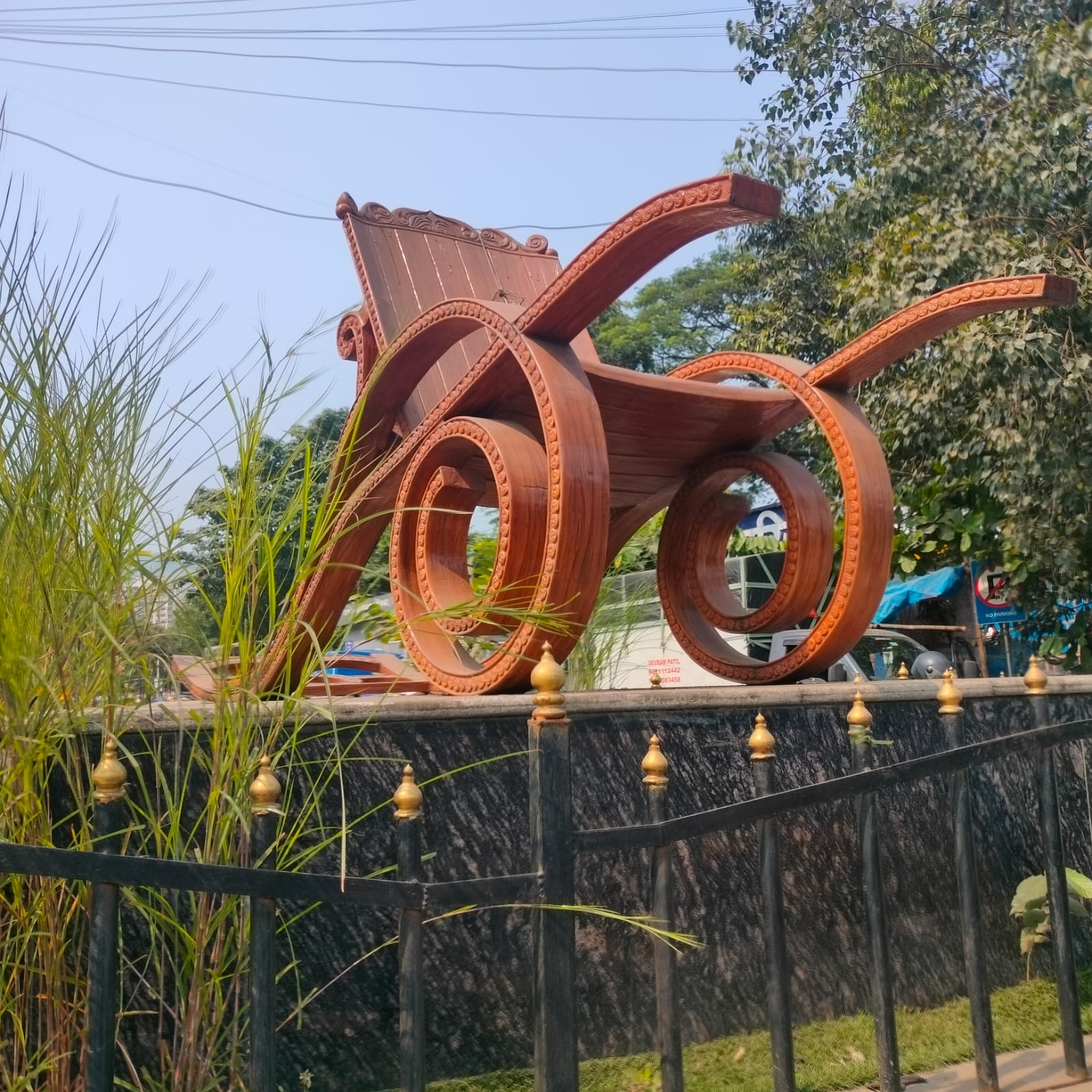
Colonial-Era Road Development
Perhaps from recognising the need for better inland connectivity, the British began road construction and upgradation projects in the early 19th century in the district. Some of them, noted in the distinct colonial Gazetteer (1882), are:
- In 1826, the route from Pune to Gujarat, which passed through the Tal pass and Bhiwandi (in present-day Thane district), was improved by military pioneer units to facilitate easier movement across the rugged terrain.
- Between 1850 and 1858, Lieutenant C. Scott of the Bombay Engineers constructed a motorable approach road from Khardi to Kasara, improving access through the hilly region.
- This work was extended by Lieutenant Chapman, who pushed the road further from Kasara (Thane district) to Igatpuri (Nashik district), creating what was described at the time as “one of the best-engineered hill roads in Western India.”
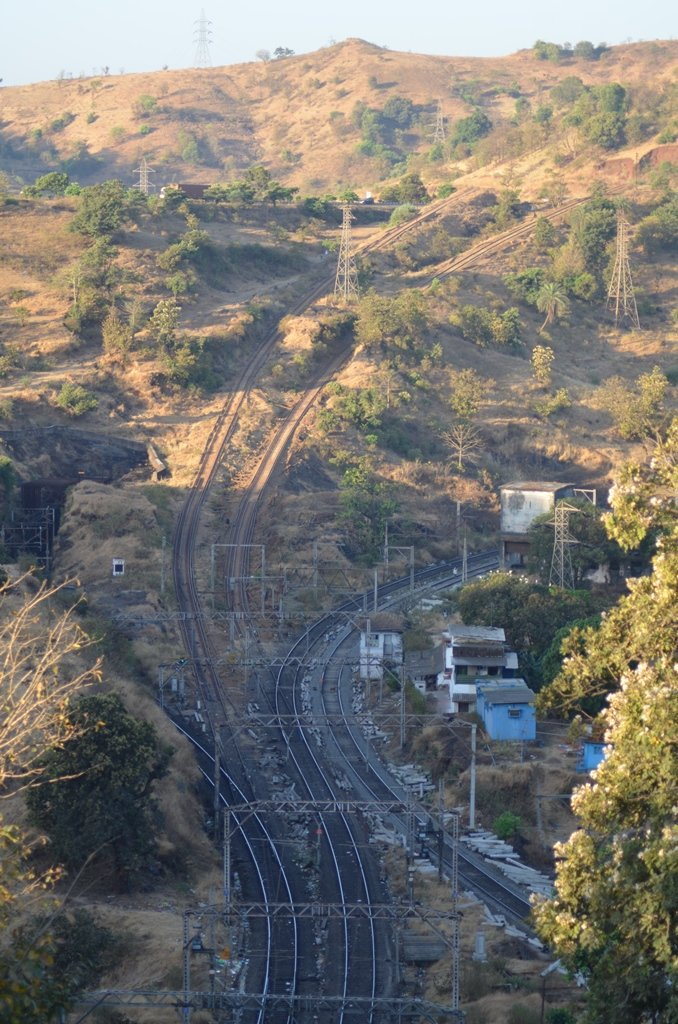
Modes of Transportation in the District
Railway Systems
Thane district today is one of the most rail-connected regions in Maharashtra. It serves as a major junction between Mumbai and the rest of the country, with railway lines that carry both local commuters and long-distance passengers.
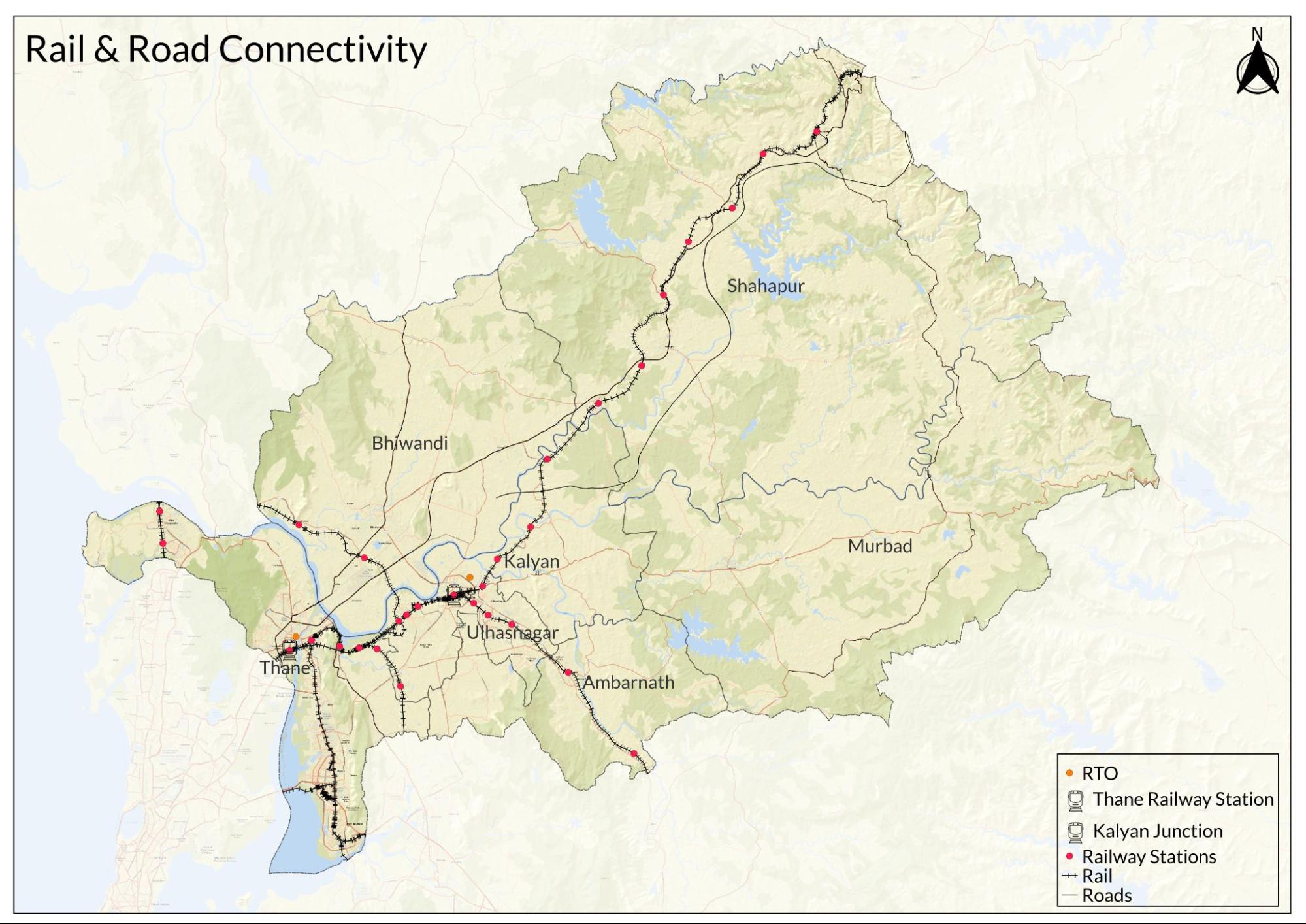
The district is part of the Central Railway zone, and several important rail routes pass through it:
- The Mumbai–Kalyan–Igatpuri–Nashik line connects Mumbai to northern and central India.
- The Mumbai–Kalyan–Karjat line leads towards Pune and the southern regions.
- Local rail lines such as the Mumbai Suburban Railway’s Central Line, Harbour Line, and Trans-Harbour Line connect towns like Thane, Kalyan, Ulhasnagar, Dombivli, and more to Mumbai’s city centre.

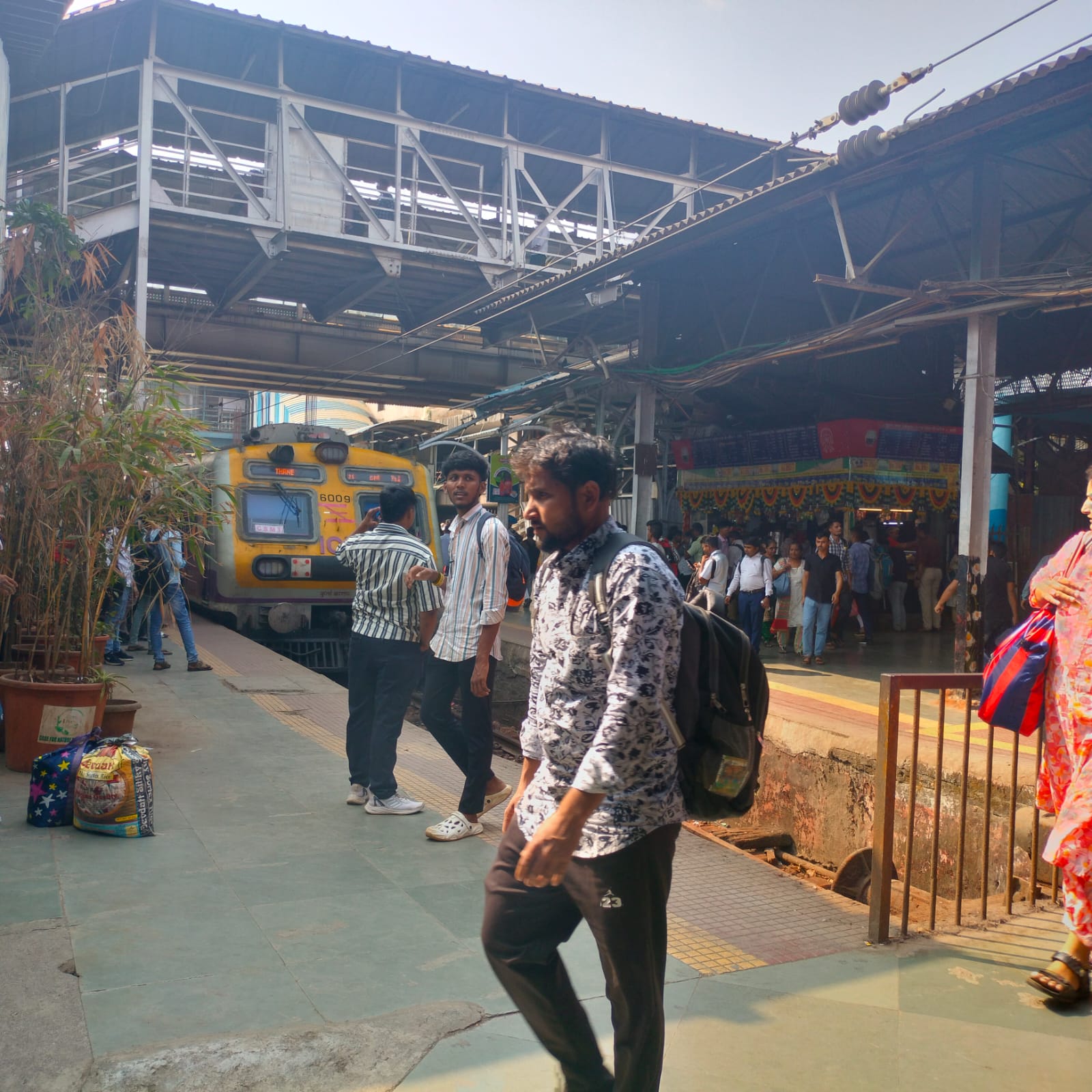
The roots of this extensive railway system can be traced back to the mid-19th century, when the Thane district became the site of a landmark moment in Indian transport history. On 16 April 1853, the first passenger train in India ran from Bori Bunder (Mumbai) to Thane, marking the beginning of railway operations in the country. This early line was part of what became the Great Indian Peninsula Railway (GIPR), and Thane soon became a key point in its expansion.
From Thane, the railway line was extended to Kalyan in 1854. After that, it branched into two major routes that crossed the rugged Sahyadri (Western Ghat) range:
- The Northeast Line – from Kalyan to Kasara and onward to Igatpuri (completed by 1865), leading toward Nashik and Jabalpur (Madhya Pradesh).
- The Southeast Line – from Kalyan to Khandala (via Palasdhari and the Bor Ghat), leading toward Pune and the south.
In many ways, the railway has remained one of the most transformative elements in the development of the Thane district. It facilitated not only the movement of people and goods but also helped integrate the district with Mumbai and the wider subcontinent, influencing settlement patterns, urbanisation, and industrial development.
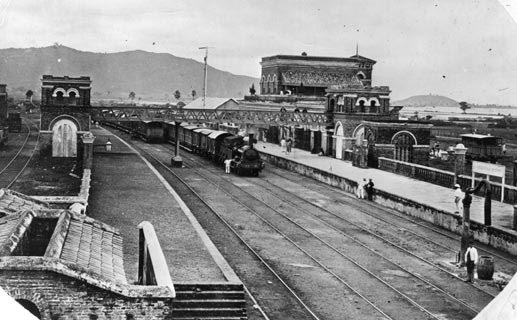

Ferries & Water Transport
Before the rise of roads and railways, ferries were essential to daily life in the Thane district. With creeks and rivers separating many towns and villages, water routes provided the most practical means of transport for people, goods, and animals. While today these services have largely faded, replaced by bridges and highways, the 1882 Thane District Gazetteer offers a glimpse into a time when ferries were a primary mode of local mobility.
In the late 19th century, ferries operated regularly between places like Thane, Kalwa, Kalyan, Vasai, and more. Contractors paid the government for the right to run these services, and records from 1880 show that over 40 ferries were in use across the district, including in regions like Salsette, Bhiwandi, Kalyan, Shahapur, and Vasai.
Two kinds of boats were commonly used:
- Single boats (colloquially called machvas) were decked wooden vessels, usually owned by contractors. These could carry about 20 passengers, along with carts and animals.
- Double boats (taraphas) were built by joining two boats with a platform large enough to hold four bullock carts. These were often funded by local authorities.
All boats were traditionally made from teak wood in Thane and came equipped with masts, sails, oars, and punting poles. The crews were mostly drawn from local Koli and Muslim fishing communities, who managed these routes as a livelihood. Today, while most of these ferry services have disappeared, they remain an important part of the district's transport history, showing how much movement once depended on water.
Overview of Bus Networks
In the present day, buses form the backbone of public transport across the Thane district. A wide range of services is operated by both municipal transport bodies and the state transport system, providing daily connectivity within towns and to neighboring cities like Mumbai, Pune, and Nashik. Major operators here include:
- TMT (Thane Municipal Transport)
- KDMT (Kalyan-Dombivli Municipal Transport)
- MBMT (Mira-Bhayandar Municipal Transport)
- NMMT (Navi Mumbai Municipal Transport)
- VVMT (Vasai-Virar Municipal Transport)
- MSRTC (Maharashtra State Road Transport Corporation)
These providers manage routes that range from short intra-city links to longer inter-city journeys. With so many operators and routes, buses remain one of the most common and affordable ways for people in the Thane district to travel every day.
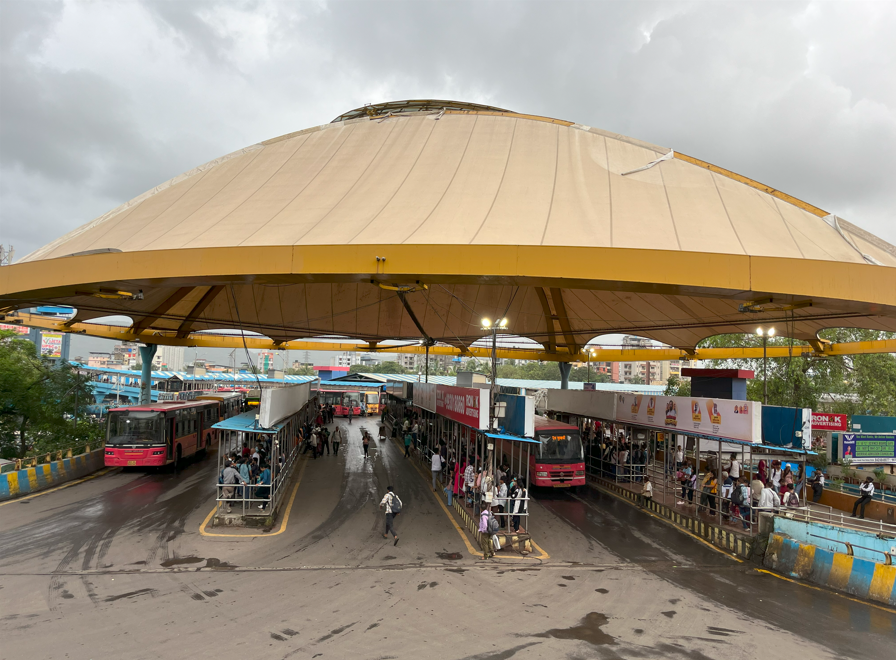
Among the many service providers, Thane Municipal Transport (TMT) is the primary public bus service operated by the Thane Municipal Corporation. It was established in 1989 and provides intra-city transport within Thane city and its suburbs, including Kalwa, Mumbra, Diva, and Wagle Estate, and also connects to nearby areas such as Bhiwandi, Navi Mumbai, Mira–Bhayandar, and Mumbai.
According to the Draft Revised Plan for 2026-46, TMT “operates with a fleet of 320 buses operating across 110 routes, of which 62 routes across 336 stops are intra-city routes. [and] as per the Economic Survey of Maharashtra Report 2021, the average number of vehicles operated by TMT on the road per day is 156, whereas, average number of passengers carried per day is around 53,000.”
Its services include regular, semi-luxury, and recently introduced electric buses. The network plays a central role in local mobility, especially for working-class and middle-income commuters.
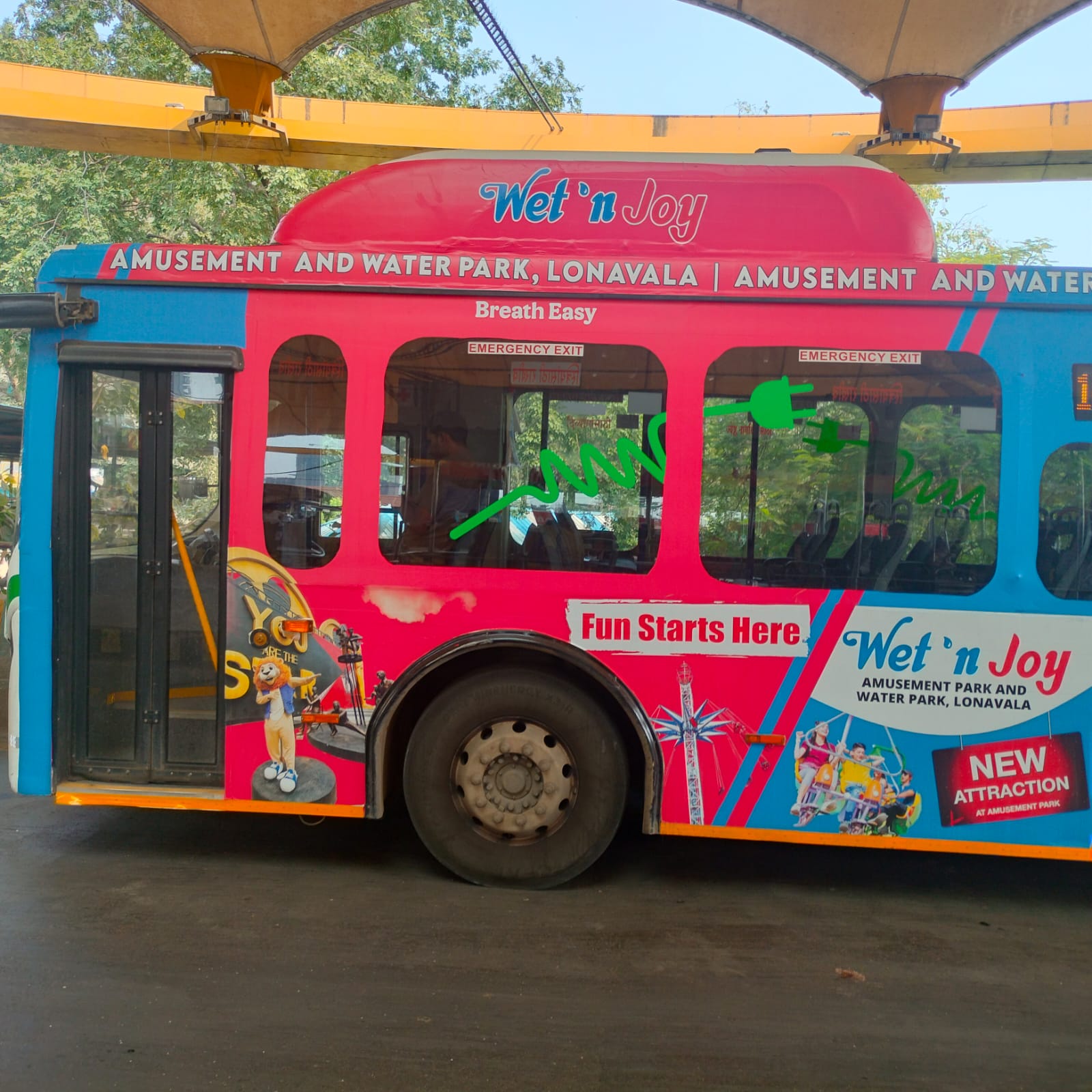
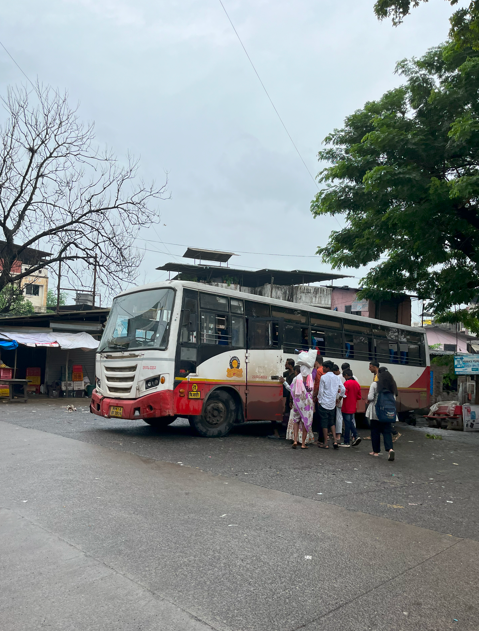
Metro Services
As of 2025, metro services in the Thane district are under construction but not yet operational. Two major lines from the Mumbai Metro network are planned to serve the district, namely Line 4 (Green Line), which will run from Wadala to Kasarvadavali and Line 5 (Orange Line), which will run from Thane to Kalyan via Bhiwandi.
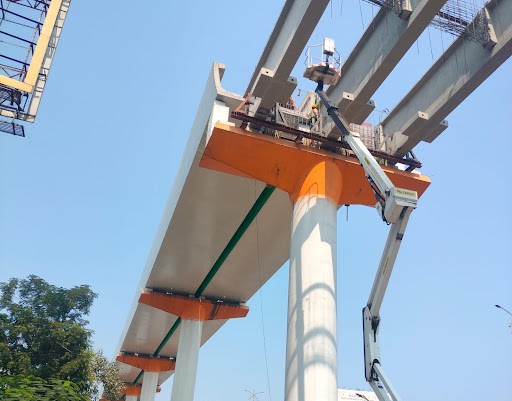
Autos & Shared Vehicles
Auto-rickshaws are a common mode of transport across the Thane district, especially for short distances and first/last-mile connectivity. They are widely available in areas like Thane city, Kalyan, Dombivli, and Mira–Bhayandar, and are typically hired directly or via mobile apps.
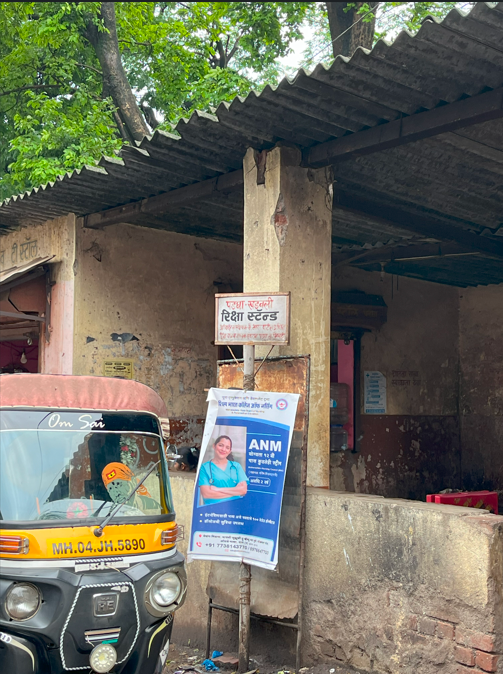
Shared autos, six-seaters, and private vans are also used for daily conveyance in the district. These vehicles operate on fixed routes with standard fares and are commonly used by office-goers, students, and market visitors. While informal, they play an important role in daily local travel.
Traffic Map
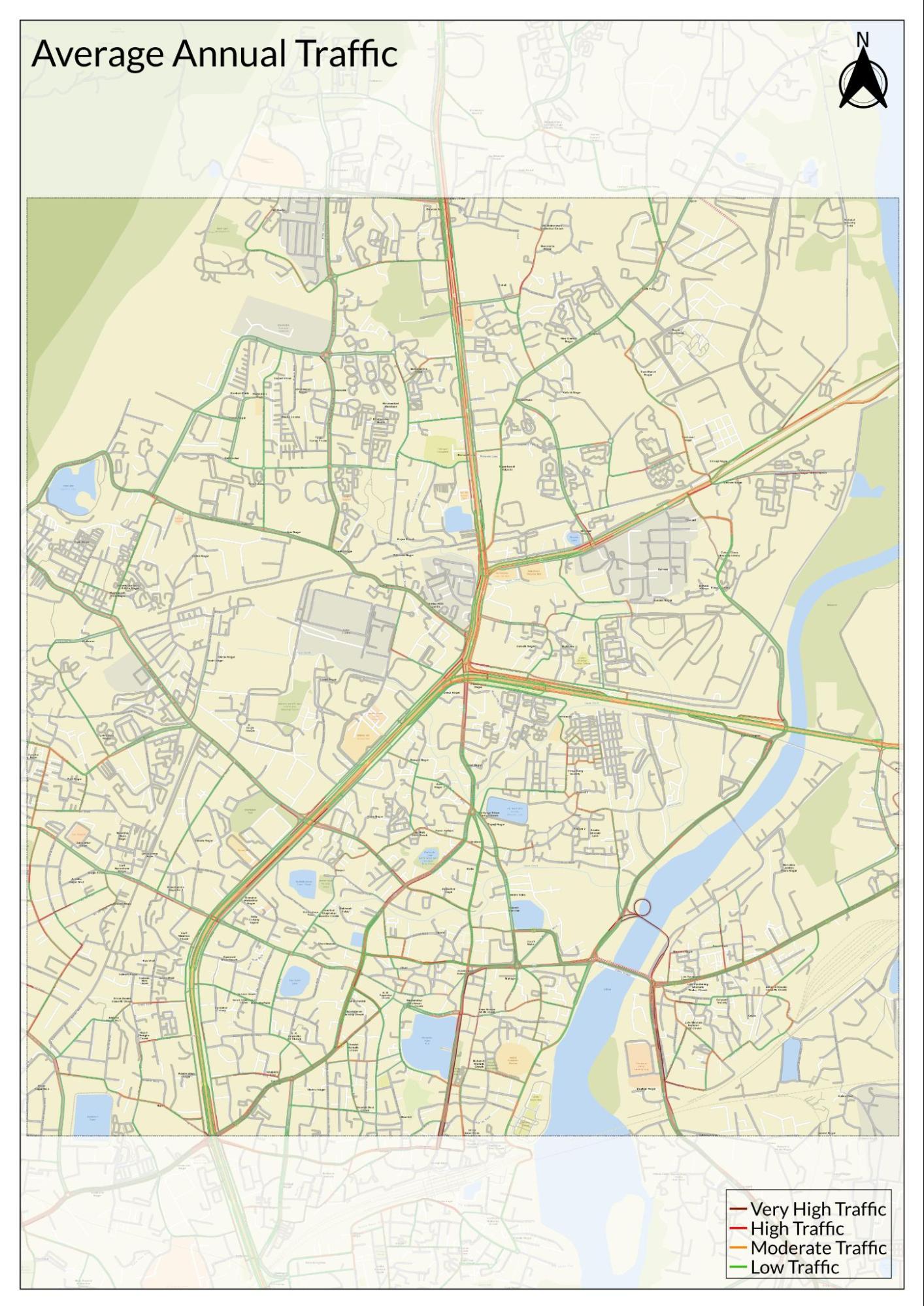
Communication Networks
Newspapers & Magazines
In the 1880s, the Thane district supported a small but active print culture. According to the district Gazetteer (1882), several weekly Marathi newspapers were printed in Thane city, including Arunodaya (Dawn), Suryodaya (Sunrise), and Hindu Punch. These papers were modest in size but important in reach, reflecting the early spread of regional journalism during the colonial period.
Today, the print media in the district, as is the case in many other places, is more diverse and commercially structured, with local editions of major Marathi and English-language dailies available across the city and suburbs. Marathi publications like Loksatta, Maharashtra Times, Lokmat, Sakal, Pudhari, and Thane Vaibhav are widely read. Many of these carry city-specific sections, highlighting civic news, political updates, cultural events, and neighbourhood issues. In English, The Times of India, Thane Plus, and Hindustan Times, HT Thane supplements are circulated in parts of the district, offering localised content alongside metro and national coverage.
Graphs
Road Safety and Violations
Transport Infrastructure
Bus Transport
Communication and Media
Sources
Gazetteer of the Bombay Presidency.1882.Thana District.Parts I and II. Superintendent of Government Printing, Bombay.
Thane Municipal Corporation.Draft Development Plan (2026–2046).https://thanecity.gov.in/tmc/cache/1/15-Oct-…
Wikipedia contributors."Green Line (Mumbai Metro)."Wikipedia. Accessed June 26, 2025.https://en.wikipedia.org/wiki/Green_Line_(Mumbai_Metro)https://en.wikipedia.org/wiki/Green_Line_(Mu…
Wikipedia contributors."Kalyan Dombivli Municipal Transport."Wikipedia. Accessed June 26, 2025.https://en.wikipedia.org/wiki/Kalyan-Dombivli_Municipal_Transporthttps://en.wikipedia.org/wiki/Kalyan-Dombivl…
Wikipedia contributors."Orange Line (Mumbai Metro)."Wikipedia. Accessed June 26, 2025.https://en.wikipedia.org/wiki/Orange_Line_(Mumbai_Metro)https://en.wikipedia.org/wiki/Orange_Line_(M…
Wikipedia contributors."Thane Municipal Transport."Wikipedia. Accessed June 26, 2025.https://en.wikipedia.org/wiki/Thane_Municipal_Transporthttps://en.wikipedia.org/wiki/Thane_Municipa…
World Health Organization. 2024.Road Safety.WHO, Geneva .https://www.who.int/health-topics/road-safet…
Last updated on 6 November 2025. Help us improve the information on this page by clicking on suggest edits or writing to us.